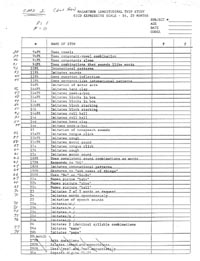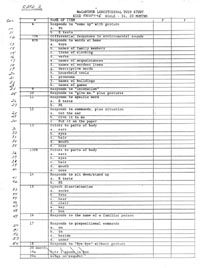


|

|
| Expressive SICD form |
Receptive SICD form |
1. These are low frequency pass items.
2. They were inconsistently given to all children.
3. Children who were given these items were likely to be at the high end of ability.
| Index of variable names and their labels | |
| Variable | Label |
| TWINID | Twin ID |
| V1SICTDY | 14M SICD:† Test date year |
| V1SICTDM | 14M SICD:† Test date month |
| V1SICTDD | 14M SICD:† Test date day |
| V1SICTDT | 14M SICD:† Test date |
| V1SICIVR | 14M SICD:† Interviewer |
| V1SIC1 | 14M SICD-Exp:† SCE9aPR-Uses vowels-Parental report |
| V1SIC2 | 14M SICD-Exp:† SCE9bPR-Uses consonant-vowel combination-Parental report |
| V1SIC3 | 14M SICD-Exp:† SCE9cPR-Uses consonants alone-Parental report |
| V1SIC4 | 14M SICD-Exp:† SCE9dPR-Uses combinations that sounds like words-Parental report |
| V1SIC5 | 14M SICD-Exp:† SCE10PR-Intonational patterns-Parental report |
| V1SIC6 | 14M SICD-Exp:† SCE11PR-Imitates sounds-Parental report |
| V1SIC7 | 14M SICD-Exp:† SCE12PR-Uses question inflection-Parental report |
| V1SIC8 | 14M SICD-Exp:† SCE13PR-Uses sentence-like intonational patterns-Parental report |
| V1SIC9 | 14M SICD-Exp:† SCE14dPR-Imitates hand clap-Parental report |
| V1SIC10 | 14M SICD-Exp:† SCE14ePR-Imitates peek-a-boo-Parental report |
| V1SIC11 | 14M SICD-Exp:† SCE14aPR-Imitates blocks in box-Parental report |
| V1SIC12 | 14M SICD-Exp:† SCE14a-Imitates blocks in box |
| V1SIC13 | 14M SICD-Exp:† SCE14bPR-Imitates block stacking-Parental report |
| V1SIC14 | 14M SICD-Exp:† SCE14b-Imitates block stacking |
| V1SIC15 | 14M SICD-Exp:† SCE14cPR-Imitates roll ball-Parental report |
| V1SIC16 | 14M SICD-Exp:† SCE14c-Imitates roll ball |
| V1SIC17 | 14M SICD-Exp:† SCE14d-Imitates hand clap |
| V1SIC18 | 14M SICD-Exp:† SCE14e-Imitates peek-a-boo |
| V1SIC19 | 14M SICD-Exp:† SCE15aPR-Imitates tongue click-Parental report |
| V1SIC20 | 14M SICD-Exp:† SCE15bPR-Imitates cough-Parental report |
| V1SIC21 | 14M SICD-Exp:† SCE15cPR-Imitates motor sound-Parental report |
| V1SIC22 | 14M SICD-Exp:† SCE15a-Imitates tongue click |
| V1SIC23 | 14M SICD-Exp:† SCE15b-Imitates cough |
| V1SIC24 | 14M SICD-Exp:† SCE15c-Imitates motor sound |
| V1SIC25 | 14M SICD-Exp:† SCE16PR-Uses consistent sound combinations as words-Parental report |
| V1SIC26 | 14M SICD-Exp:† SCE17PR-Responds to "Hi"-Parental report |
| V1SIC27 | 14M SICD-Exp:† SCE18PR-Imitates intonational patterns-Parental report |
| V1SIC28 | 14M SICD-Exp:† SCE19PR-Gestures to "ask names of things"-Parental report |
| V1SIC29 | 14M SICD-Exp:† SCE20PR-Uses "No" or "No-No"-Parental report |
| V1SIC30 | 14M SICD-Exp:† SCE22a-Names picture "baby" |
| V1SIC31 | 14M SICD-Exp:† SCE22b-Names picture "shoe" |
| V1SIC32 | 14M SICD-Exp:† SCE22c-Names picture "ball" |
| V1SIC33 | 14M SICD-Exp:† SCE23-Imitates 2 of 5 words on request |
| V1SIC34 | 14M SICD-Exp:† SCE24-Imitates words spontaneously |
| V1SIC35 | 14M SICD-Exp:† SCE25a-Imitates /ai/ |
| V1SIC36 | 14M SICD-Exp:† SCE25b-Imitates /m/ |
| V1SIC37 | 14M SICD-Exp:† SCE25c-Imitates /n/ |
| V1SIC38 | 14M SICD-Exp:† SCE25d-Imitates /q/ |
| V1SIC39 | 14M SICD-Exp:† SCE25e-Imitates /p/ |
| V1SIC40 | 14M SICD-Exp:† SCE26a-Imitates "mama" |
| V1SIC41 | 14M SICD-Exp:† SCE26b-Imitates "papa" |
| V1SIC42 | 14M SICD-Rec:† SCR6aPR-Responds to "Come up" with gesture-Parental report |
| V1SIC43 | 14M SICD-Rec:† SCR6b-Responds to "Come up" with gesture |
| V1SIC44 | 14M SICD-Rec:† SCR7PR-Differential responses to environmental sounds-Parental report |
| V1SIC45 | 14M SICD-Rec:† SCR8aPR-Responds to words at home-toys-Parental report |
| V1SIC46 | 14M SICD-Rec:† SCR8bPR-Responds to words at home-names of family members-Parental report |
| V1SIC47 | 14M SICD-Rec:† SCR8cPR-Responds to words at home-items of clothing-Parental report |
| V1SIC48 | 14M SICD-Rec:† SCR8dPR-Responds to words at home-verbs-Parental report |
| V1SIC49 | 14M SICD-Rec:† SCR8ePR-Responds to words at home-names of acquaintances-Parental report |
| V1SIC50 | 14M SICD-Rec:† SCR8fPR-Responds to words at home-names of outdoor items-Parental report |
| V1SIC51 | 14M SICD-Rec:† SCR8gPR-Responds to words at home-descriptive words-Parental report |
| V1SIC52 | 14M SICD-Rec:† SCR8hPR-Responds to words at home-household tools-Parental report |
| V1SIC53 | 14M SICD-Rec:† SCR8iPR-Responds to words at home-pronouns-Parental report |
| V1SIC54 | 14M SICD-Rec:† SCR8jPR-Responds to words at home-names of buildings-Parental report |
| V1SIC55 | 14M SICD-Rec:† SCR8kPR-Responds to words at home-names of games-Parental report |
| V1SIC56 | 14M SICD-Rec:† SCR9-Responds to "intonation" |
| V1SIC57 | 14M SICD-Rec:† SCR10-Responds to"give me," plus gestures |
| V1SIC58 | 14M SICD-Rec:† SCR11a-Responds to specific word |
| V1SIC59 | 14M SICD-Rec:† SCR11bPR-Responds to specific word-Parental report |
| V1SIC60 | 14M SICD-Rec:† SCR12a-Responds to commands, plus situation-"Get the car" |
| V1SIC61 | 14M SICD-Rec:† SCR12b-Responds to commands, plus situation-"Give it to me" |
| V1SIC62 | 14M SICD-Rec:† SCR12c-Responds to commands, plus situation-"Put it on the paper" |
| V1SIC63 | 14M SICD-Rec:† SCR13a-Points to ears |
| V1SIC64 | 14M SICD-Rec:† SCR13b-Points to eyes |
| V1SIC65 | 14M SICD-Rec:† SCR13c-Points to hair |
| V1SIC66 | 14M SICD-Rec:† SCR13d-Points to mouth |
| V1SIC67 | 14M SICD-Rec:† SCR13e-Points to nose |
| V1SIC68 | 14M SICD-Rec:† SCR13aPR-Points to ears-Parental report |
| V1SIC69 | 14M SICD-Rec:† SCR13bPR-Points to eyes-Parental report |
| V1SIC70 | 14M SICD-Rec:† SCR13cPR-Points to hair-Parental report |
| V1SIC71 | 14M SICD-Rec:† SCR13dPR-Points to mouth-Parental report |
| V1SIC72 | 14M SICD-Rec:† SCR13ePR-Points to nose-Parental report |
| V1SIC73 | 14M SICD-Rec:† SCR14a-Responds to sit down/stand up |
| V1SIC74 | 14M SICD-Rec:† SCR14bPR-Responds to sit down/stand up-Parental report |
| V1SIC75 | 14M SICD-Rec:† SCR15a-Speech discrimination-socks |
| V1SIC76 | 14M SICD-Rec:† SCR15b-Speech discrimination-tree |
| V1SIC77 | 14M SICD-Rec:† SCR15c-Speech discrimination-bear |
| V1SIC78 | 14M SICD-Rec:† SCR15d-Speech discrimination-chair |
| V1SIC79 | 14M SICD-Rec:† SCR15e-Speech discrimination-key |
| V1SIC80 | 14M SICD-Rec:† SCR15f-Speech discrimination-box |
| V1SIC81 | 14M SICD-Rec:† SCR16-Responds to the name of a fimiliar person |
| V1SIC82 | 14M SICD-Rec:† SCR17a-Responds to prepositional commands-on |
| V1SIC83 | 14M SICD-Rec:† SCR17b-Responds to prepositional commands-in |
| V1SIC84 | 14M SICD-Rec:† SCR17c-Responds to prepositional commands-beside |
| V1SIC85 | 14M SICD-Rec:† SCR17d-Responds to prepositional commands-under |
| V1SIC86 | 14M SICD-Rec:† SCR18-Responds to "Bye-bye" without gesture |
| V1SICDE | 14M SICD-Exp:† Total Expressive scales corrected for missing data |
| V1SICDR | 14M SICD-Rec:† Total Receptive scales corrected for missing data |
| V1SICCOM | 14M SICD: Comments |
Bayley Scales of Infant Development (Mental Development Scales) and Sequenced Inventory of Communication Development
These two assessments were integrated into one procedure at 14, 20, and 24 months, a more natural and more efficient presentation for children of these ages. The Bayley consists of many tasks representative of problem solving, fine motor coordination, and expressive and receptive vocabulary. Mothers were told that the children’s best performance may depend on either her close proximity or, conversely, her absence during this assessment. Examiners proceeded with each child until a baseline and ceiling of the child’s abilities was obtained. Children who became distressed were permitted to complete testing while sitting on their mother’s lap. The Bayley Scales assessed each child’s level of general cognitive development as compared with other children of the same age.
The Sequenced Inventory of Communication Development was used to assess each childís receptive and productive language. This included a separate Parental Report Interview in which, at a later point in the visit, motherís were asked questions pertaining to each childís expressive and receptive communication.